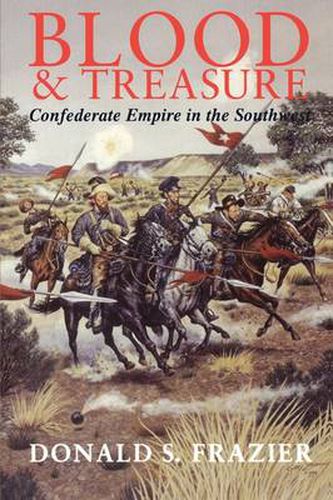Readings Newsletter
Become a Readings Member to make your shopping experience even easier.
Sign in or sign up for free!
You’re not far away from qualifying for FREE standard shipping within Australia
You’ve qualified for FREE standard shipping within Australia
The cart is loading…






This title is printed to order. This book may have been self-published. If so, we cannot guarantee the quality of the content. In the main most books will have gone through the editing process however some may not. We therefore suggest that you be aware of this before ordering this book. If in doubt check either the author or publisher’s details as we are unable to accept any returns unless they are faulty. Please contact us if you have any questions.
For decades before the Civil War, Southern writers and warriors had been urging the occupation and development of the American Southwest. When the rift between North and South had been finalized in secession, the Confederacy moved to extend their traditions to the west-a long-sought goal that had been frustrated by northern states. It was a common sentiment among Southerners and especially Texans that Mexico must be rescued from indolent inhabitants and granted the benefits of American civilization. Blood and Treasure , written in a readable narrative style that belies the rigorous research behind it, tells the story of the Confederacy’s ambitious plan to extend a Confederate empire across the continent. Led by Lieutenant Colonel John R. Baylor, later a governor of Arizona, and General H. H. Sibley, Texan soldiers trekked from San Antonio to Fort Bliss in El Paso, then north along the Rio Grande to Santa Fe. Fighting both Apaches and Federal troops, the half-trained, undisciplined army met success at the Battle of Val Verde and defeat at the Battle of Apache Canyon. Finally, the Texans won the Battle of Glorieta Pass, only to lose their supply train–and eventually the campaign. Pursued and dispirited, the Confederates abandoned their dream of empire and retreated to El Paso and San Antonio. Frazier has made use of previously untapped primary sources, allowing him to present new interpretations of the famous Civil War battles in the Southwest. Using narratives of veterans of the campaign and official Confederate and Union documents, the author explains how this seemingly far-fetched fantasy of building a Confederate empire was an essential part of the Confederate strategy. Military historians will be challenged to modify traditional views of Confederate imperial ambitions. Generalists will be drawn into the fascinating saga of the soldiers’ fears, despair, and struggles to survive.
$9.00 standard shipping within Australia
FREE standard shipping within Australia for orders over $100.00
Express & International shipping calculated at checkout
This title is printed to order. This book may have been self-published. If so, we cannot guarantee the quality of the content. In the main most books will have gone through the editing process however some may not. We therefore suggest that you be aware of this before ordering this book. If in doubt check either the author or publisher’s details as we are unable to accept any returns unless they are faulty. Please contact us if you have any questions.
For decades before the Civil War, Southern writers and warriors had been urging the occupation and development of the American Southwest. When the rift between North and South had been finalized in secession, the Confederacy moved to extend their traditions to the west-a long-sought goal that had been frustrated by northern states. It was a common sentiment among Southerners and especially Texans that Mexico must be rescued from indolent inhabitants and granted the benefits of American civilization. Blood and Treasure , written in a readable narrative style that belies the rigorous research behind it, tells the story of the Confederacy’s ambitious plan to extend a Confederate empire across the continent. Led by Lieutenant Colonel John R. Baylor, later a governor of Arizona, and General H. H. Sibley, Texan soldiers trekked from San Antonio to Fort Bliss in El Paso, then north along the Rio Grande to Santa Fe. Fighting both Apaches and Federal troops, the half-trained, undisciplined army met success at the Battle of Val Verde and defeat at the Battle of Apache Canyon. Finally, the Texans won the Battle of Glorieta Pass, only to lose their supply train–and eventually the campaign. Pursued and dispirited, the Confederates abandoned their dream of empire and retreated to El Paso and San Antonio. Frazier has made use of previously untapped primary sources, allowing him to present new interpretations of the famous Civil War battles in the Southwest. Using narratives of veterans of the campaign and official Confederate and Union documents, the author explains how this seemingly far-fetched fantasy of building a Confederate empire was an essential part of the Confederate strategy. Military historians will be challenged to modify traditional views of Confederate imperial ambitions. Generalists will be drawn into the fascinating saga of the soldiers’ fears, despair, and struggles to survive.